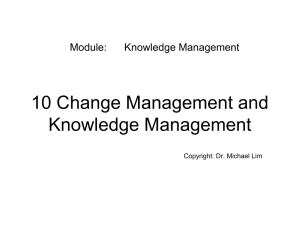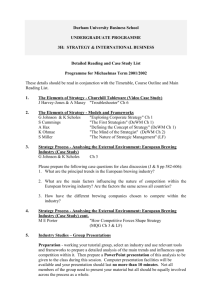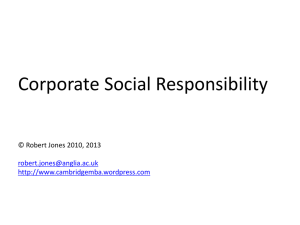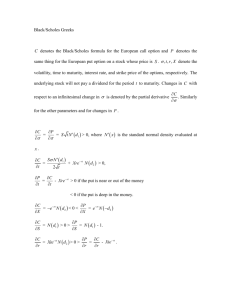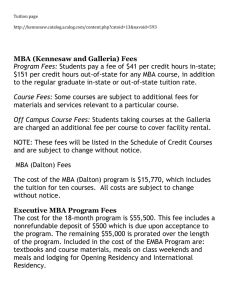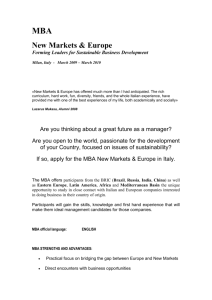Course Outline - Durham University Community
advertisement
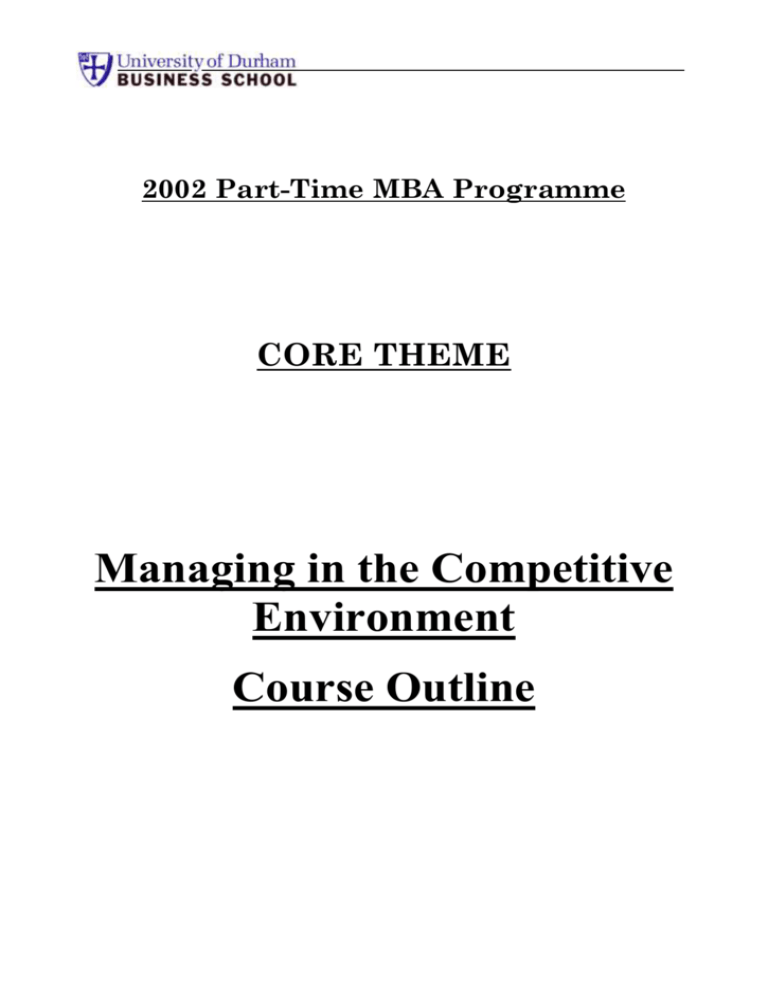
2002 Part-Time MBA Programme CORE THEME Managing in the Competitive Environment Course Outline 2002 PT MBA Programme Managing in the Competitive Environment Course Outline 2 TEACHING STAFF: Peter Allen Extension: 2253 E-mail: p.j.allen@durham.ac.uk Brian McGarrie Extension: 1420 E-mail: brian.mcgarrie@durham.ac.uk Mike Nicholson Extension: 3392 E-mail: mike.nicholson@durham.ac.uk COURSE AIMS This theme explores the environmental pressures at work on organisations, how they can respond to these influences, and the management issues involved in aligning with these forces. Specially, the theme takes an integrated perspective of the operating environment of the organisation. Firstly, it explores the processes of developing strategy and making strategic choices in order to develop a critical appreciation of the organisation and the environment. Secondly, it considers how a market orientation that focuses on customers and stakeholders and a detailed understanding of the structure of markets acts as means to unify strategic decisions and operational actions by appropriate conceptualisation, design, pricing, promotion and delivery of products or services. Thirdly, the theme examines how managers deliver these plans by effective operational management in terms of the design, planning, control, forecasting and management of resources. A particular feature is the way in which the theme not only conceptualises the strategic pressures faced by organisations, but also identifies the main issues that need to be addressed by individual managers. LEARNING OBJECTIVES OF THE COURSE To develop an integrated appreciation of the key business areas that need to be managed in a competitive operating environment; emphasis on process and integration rather than functional ‘silos’ To appreciate the dynamic pressures of the environment, both internally with the organisation and externally To develop a critical understanding of the existing theoretical knowledge base on key areas (Strategy & Decision-making, Operations & Marketing) 2002 PT MBA Programme Managing in the Competitive Environment Course Outline SKILLS By the end of this course participants should have developed skills in: analysing the dynamic pressures of the business environment; applying theory to practice; analysing the need for integration in modern business environs. DELIVERY OF THE COURSE The course will be taught by a combination of case study-based lectures, small group and individual case study analysis, and guided reading will underpin the knowledge requirements of the course. TIMETABLE The duration of the course is 48 hours. SUMMATIVE ASSESSMENT Assessment will take the form of a 2,500 word assignment, together with an examination at the end of the course. Each will count for 50% of the total mark. At the end of the term there will be a 3 hour examination based on a seen case study. Assignment To be submitted by: 12 noon on Saturday 16th March 2002 Please hand in to the Postgraduate Office and obtain a receipt. Length: No more than 2,500 words, excluding appendices. Details: Case study and briefing document introduced in session 16. Notes: * Please type the assignment, giving the number of words at the end. Type on one side of the page only using double-spacing and fasten assignment by stapling at top lefthand corner. * Any literature referred to in the text should be included in a list of References at the end. Please refer to the MBA handbook for details of recommended referencing system. * Always keep a copy of all your assignments as the originals will not be returned. 3 2002 PT MBA Programme Managing in the Competitive Environment Course Outline Examination The examination will be of three hours duration and will take place on Friday 10th May 2002, 2.00pm – 5.00pm. READING Below is a list of some key texts that you may find helpful. Specific reading for each week is detailed further in the course reader to be issued at the start of the course. All the main texts are in the library and, in addition, there are copies of some articles in the library reprints file. CORE TEXT/S Johnson, G. and Scholes, K., (2002), Exploring Corporate Strategy, 6th edition, London: Financial Times Prentice Hall Slack, N., et all (2000), Operations Management, 3rd edition, London: Pitman Publishing FURTHER USEFUL SOURCES A Course Reader containing a number of relevant articles and extracts will be provided at the start of the course. Most of the relevant case studies for classroom sessions will also be provided in the reader. SYLLABUS a ) Introduction Inter-disciplinary case study analysis (strategy, operations, marketing) b) Strategy Nature of strategy: definitions; deliberate – emergent debate Sustainable Competitive Advantage - strategic capabilities; environmental analysis, resource and capabilities analysis, positioning and resource-based approaches Strategy process: schools and models, stakeholder analysis, cultural analysis, mission and objectives Corporate strategy: directions, acquisitions and alliances, synergy and management styles, parenting c) Marketing Achieving marketing orientation 4 2002 PT MBA Programme Managing in the Competitive Environment Course Outline The customer imperative; the marketing philosophy, sources of value, markets and the environment, buyer behaviour Defining strategic pathways; segmentation, targeting and positioning Issues to manage – market research, product policy, pricing strategies, distribution, marketing communications d) Operations Operations objectives and Strategy Product/service design, network design, job design, role of technology Planning and Control; capacity, inventory, Just-In-Time, quality, projects Improvement philosophies e) Summary Inter-disciplinary case - preparation for assessment READING FOR SPECIFIC TOPICS SESSIONS Session 1 – Introduction Further Reading Lecture Note G Johnson & K Scholes An introduction to managing in the competitive environment Exploring Corporate Strategy, Ch 1 Case Study Video Case Study: Churchill Tableware Session 2 – The Political and Cultural Contexts of Strategy Reading Lecture Note G Johnson & K Scholes The political and cultural contexts of strategy Exploring Corporate Strategy, Chs 2 & 5 Case Study Does Marks & Spencer have a future? [see Course Reader] Use the following questions to help prepare your case study analysis: 1. Identify the cultural web in Marks & Spencer in 1998? 2. What went wrong in Marks & Spencer and does it have a future? 5 2002 PT MBA Programme Managing in the Competitive Environment Course Outline Session 3 – Strategy Process and the External Environment Reading Lecture Note G Johnson & K Scholes Strategy Process and the External Environment Exploring Corporate Strategy, Ch 3 Case Study The European Brewing Industry (Johnson & Scholes pp 138-143) Use the following questions to help prepare your case study analysis: 1. Assess the principal trends and pressures within the European brewing industry. 2. What are the main factors influencing the nature of competition within the European brewing industry? Are the factors the same across all countries? 3. How have the different brewing companies chosen to compete within the industry? Session 4 – Understanding Strategic Capabilities Reading Lecture Note G Johnson & K Scholes Understanding strategic capabilities Exploring Corporate Strategy, Ch 4 Case Study Brasseries Kronenbourg Use the following questions to help prepare your case study analysis: 1. Outline the main resources and competences of Brasseries Kronenbourg, identifying the ways in which they contribute to its strategy. 2. Identify the sources of competitive advantage that Brasseries Kronenbourg seeks to exploit. Session 5 – Creating and Sustaining Competitive Advantage Reading Lecture Note G Johnson & K Scholes Further Reading M E Porter G Stalk, P Evans & L Shulman Creating and sustaining competitive advantage Exploring Corporate Strategy, Ch 7 “Competitive strategy”, in R De Wit & R Meyer (1998), Strategy: Process, Content, Context, International Thompson Business Press (DeWM) pp 344-358 “Competing on capabilities”, Harvard Business Review (HBR), March-April 1992 6 2002 PT MBA Programme Managing in the Competitive Environment Course Outline R M Grant M E Porter “The resource-based theory of competitive advantage: implications for strategy formulation”, California Management Review (CMR), 33 (4) pp 97-115 “What is strategy?”, HBR, November-December 1996 Case Study Brewery Group Denmark (Johnson & Scholes pp 910-924) Use the following questions to help prepare your case study analysis: 1. How has the Brewery Group Denmark chosen to position itself against its competitors? 2. In the light of your analysis of the trends and competitive pressures within the brewing industry, assess the future sustainability of the Brewery Group Denmark’s strategy? Session 6 – Corporate Strategy: Methods and Directions Reading Lecture Note – Corporate Strategy: directions and methods G Johnson & K Scholes Exploring Corporate Strategy, Ch 8 Further Reading M Sirower G Hamel, Y Doz & C K Prahalad S Preece “The Synergy Trap”, in DeWM pp 449-468 “Collaborate with your competitors – and win”, HBR, January/February 1989 “Incorporating international strategic alliances into overall firm strategy”, in DeWM pp 543-552 Case Study Nokia: the consumer electronics business Use the following questions to help prepare your case study analysis: 1. Outline and assess the development of Nokia’s strategy for the consumer electronics business from the mid-1970s to 1992. 2. Analyse the problems faced by Nokia within the consumer electronics business during the late 1980s and early 1990s. To what extent were the difficulties a reflection of problems typically encountered by companies who attempt to grow through acquisitions? 3. Outline and explain the restructuring of the Nokia Group from 1992 to 1996. In particular, assess the reasons behind Nokia’s withdrawal from the consumer electronics business. Session 7 – Corporate Strategy: Understanding and Managing Synergy Reading Lecture Note Corporate strategy: understanding and managing strategy 7 2002 PT MBA Programme Managing in the Competitive Environment Course Outline G Johnson & K Scholes Further Reading M E Porter C K Prahalad & G Hamel M Goold & A Campbell A Campbell & M Goold 8 Exploring Corporate Strategy, Ch 6 “From competitive advantage to corporate strategy”, HBR, May/June 1987 “The core competence of the corporation”, HBR, May/June 1990 “Adding value from corporate headquarters”, in DeWM pp 484-500 “Corporate-level strategy” in V Ambrosini et al. (1998), Exploring techniques of analysis and evaluation in strategic management, Prentice Hall Europe Case Study Burmah Castrol Chemicals Group Use the following questions to help prepare your case study analysis: 1. What are the key resources and competences of the Burmah Castrol Chemicals Group. 2. Outline and assess the alternative roles that the Group centre could play in enhancing the strategies of the business units. What would be the implications for the strategies to be followed in the future? 3. What would be your recommendations to Mike Dearden following the executive debate? Session 8 – Marketing in Context Reading Lafferty, B. A. & Hult, G.T.M. (2001), ‘A synthesis of contemporary market orientation perspectives’. European Journal of Marketing, 35(1/2), pp92-109. Aijo, T. S. (1996), ‘The theoretical and philosophical underpinnings of relationship marketing: Environmental factors behind the changing marketing paradigm’. European Journal of Marketing, 30(2), pp8-18. Case Study Corus – “Developing a strong customer focus” Session 9 – Marketing & Customers Reading Dibb et al. Ch. 4-7 Further Reading Morgan, J. J., Stoltman, F. W. & Anglin, L. K. (1999), ‘An investigation of retail shopping situations’. International Journal of Retail & Distribution Management, 27(4), pp145-153. Wilson, E. J. (1996), ‘Theory transitions in organizational buying behavior research’. 2002 PT MBA Programme Managing in the Competitive Environment Course Outline 9 Journal of Business & Industrial Marketing, 11(6), pp7-19. Beane, T. P. & Ennis, D. M. (1987), ‘Market segmentation: a review’. European Journal of Marketing, 21(5), pp20-42. Case Study Independent Insurance – “Targeting sponsorship within a specialist niche market” Use the questions provided in the case study as a guide to your analysis. Session 10 – Marketing Decisions Reading Dibb et al. Ch. 8-11 Further Reading Coomasaru, C., Day, J. & Lee, S. (1996), ‘Developing a marketing plan for Lemonhead’. Management Decision, 34(8), pp17-24. Vignali, C. (2001), ‘McDonald’s: “think global, act local”.’ British Food Journal, 103(2), pp97-111. Case Studies British Sky Broadcasting – “Building a brand leader” Heinz – “Re-launching Heinz Salad Cream” Use the questions provided in the case studies as a guide to your analysis. Session 11 – Marketing in Action Reading Dibb et al. Ch. 21-24 Further Reading Driver, J. C. (2001), ‘Airline marketing in regulatory context’. Marketing Intelligence & Planning, 19(2), pp125-135. Hoffman, D.L. & Novak, T. P. (1997), ‘A New Marketing Paradigm for Electronic Commerce’. The Information Society, 17. http://www2000.ogsm.vanderbilt.edu/papers/pdf/information.society.oct.17.1996.pdf Case Study Freeserve – “Objectives and dynamics in a rapidly expanding market” Use the questions provided in the case study as a guide to your analysis. 2002 PT MBA Programme Managing in the Competitive Environment Course Outline 10 Session 12 – Introduction to Operations Management and Strategy Reading Slack et al Ch 1-3. Further Reading Johnston, R. (1999) ‘Service operations management: return to roots’, International Journal of Operations and Production Management, vol.19, no.2, 104-124. Gagnon, S. (1999) ‘Resource-based competition and the new operations strategy’, International Journal of Operations and Production Management, vol. 19, no.2, 125-138. Case Study McDonald’s Corporation Use the following questions to help prepare your case study analysis: 1. How do McDonald’s compete operationally? 2. McDonald’s competitive advantage – Operations or Marketing? Session 13 – Product/Service Design and Network Design Reading Slack et al Ch 4-6. Further Reading Gustafsson A., Ekdahl F. and Edvardsson B. (1999) ‘Customer focused service development in practice: A case study at Scandinavian Airlines System (SAS)’, International Journal of Service Industry Management, vol.10, no.4, 344-358 Muffatto M. (1999) ‘Platform strategies in international new product development’, International Journal of Operations and Production Management, vol.19, no. 5/6, 449-459. Case Study The Boeing Commercial Airplane Group: Design Process Evolution Use the following question to help prepare your case study analysis: 1. How could Boeing improve their design process? Session 14 – Planning and Control Reading Slack et al Ch10, 12, 13, 15 2002 PT MBA Programme Managing in the Competitive Environment Course Outline 11 Further Reading Magretta J. (1998) ‘The Power of Virtual Integration: an Interview with Dell Computer’s Michael Dell’, Harvard Business Review, March-April, 73-84. Gelinas R. (1999) ‘The Just-In-Time implementation project’ International Journal of Project Management, vol.17, no. 3, 171-179. Case Study Gateway: Moving Beyond the Box Use the following question to help prepare your case study analysis: 1. Contrast and compare Gateway with Dell from a Supply Chain Management perspective Session 15 – Operations Improvement Reading Slack et al Ch 18, 20 Further Reading Wright G. (1998) ‘Perspectives on Performance Measurement Conflicts in Service Businesses’, Journal of General Management, vol.23, no.4, 35-50. Keating, E., Oliva R., Repenning N., Rockart S. and Sterman J. (1999) ‘Overcoming the Improvement Paradox’, European Management Journal, vol.17., no.2, 120-134. Case Study Webvan: Groceries on the Internet Use the following question to help prepare your case study analysis: 1. Webvan went into liquidation earlier this year – from an Operation viewpoint, how could this have been avoided? Session 16 – Integrative Session Case Study Low-Cost is Flying High Use the following questions to help prepare your case study analysis: 1. Identify and assess the strategic capabilities of EasyJet, focusing particularly upon the marketing and operations activities of the organisation. 2. Has EasyJet defined a strategy likely to deliver sustainable competitive advantage into the future?
